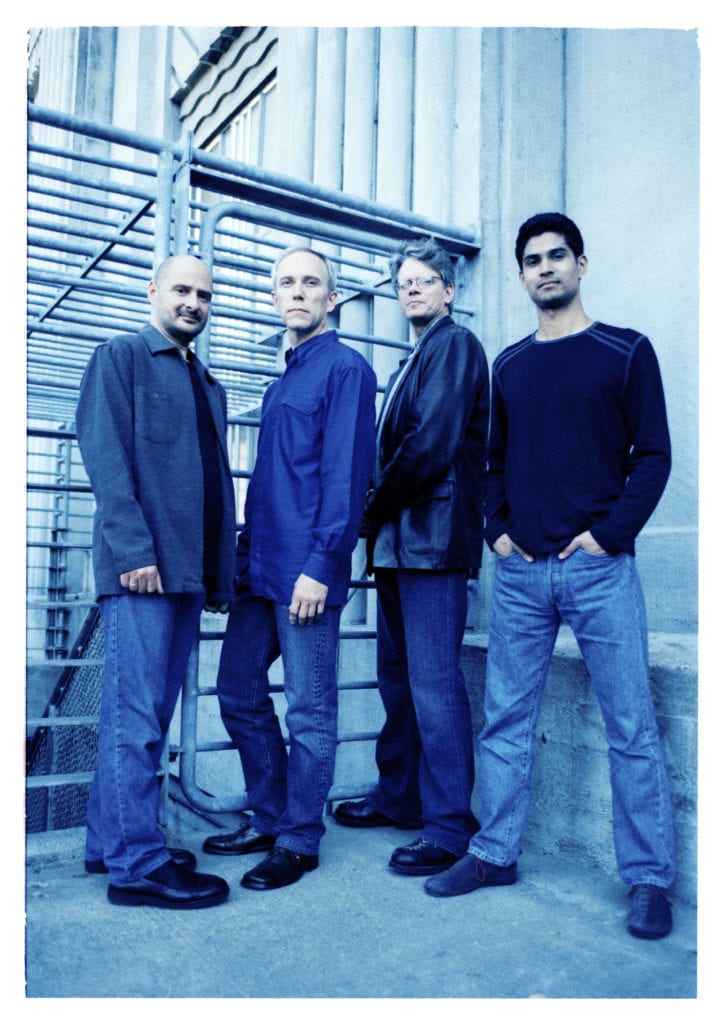


In a world premiere made possible by Kronos Quartet’s ongoing collaboration with Duke Performances, the modern era’s most adventurous quartet turned its fierce creativity toward a new, Duke-commissioned work by GRAMMY winner Maria Schneider. This was the first time these two icons of innovation worked together. The residency ran from April 8-10, 2010, culminating in a public world premiere of Maria Schneider’s new quartet on April 10, 2010 at Page Auditorium.
“[Maria Schneider] puts together stories that speak with the clarity of Ernest Hemingway and the musical grace of Aaron Copland.”
Pittsburgh Tribune
The thread we’re exploring at Duke is the binding force of various vernacular musics on the work of Kronos. Some of the material began its life in a religious setting; other pieces draw on aspects in pop culture. All the music is incredibly striking in its beauty, and its power to alter the way an audience understands what makes a concert in 2010. Finally, we want to set up Maria’s remarkable new piece with a wide ranging sonic palette.
— David Harrington, Kronos Quartet
Though some people say it’s difficult to classify my music, I’m quite comfortable calling myself a jazz composer. I meticulously compose intricate music for my own 18-piece group (which looks like a big band, but sounds more like an orchestra), but nevertheless my music almost always includes passages or layers of improvisation that undeniably stem from a jazz tradition. My world is one that includes a rhythm section and a vast array of woodwind, brass, and chordal instruments. I’m at home writing full-spectrumed and powerful sonorities. When accepting a string quartet commission, I didn’t fully realize that I’d feel so disoriented. In the context of the string quartet, I felt stripped of all my security blankets and stranded way beyond my comfort zone. The question was: How do I find my way in this foreign world where nothing felt familiar?
I tried to erase my usual palette: the orientation to large sonorities, brass and rhythm section. Those were now all absent. I tried to imagine the role of rhythm placed inside the four available melodic lines relying on no other force for propulsion, and found that I slowly grew into the challenge of it. I searched for a sonic environment where all worlds would not only connect, but actually feel at ease together, happy to be led into new territory. My music almost always attaches itself to a story, image, or experience. But here, the music slowly arrived on its own accord with absolutely no agenda other than being appreciated as sound. There was only one thoroughly appropriate title. It may be my most apt yet: String Quartet No 1.
The rhythms that emerge in the first movement (in groupings divisible by three) were highly influenced by those I’ve encountered through flamenco, and which I have used in my orchestral jazz writing. This movement passes through many key centers and finally ends with two chords typically found in flamenco that don’t feel entirely resolved. The slightly anxious final chord is actually only a very common C major chord. But, preceded by a D-flat major chord, the memory of that bottom half step between D-flat moving down to C hangs over into the C triad, giving it a lingering dark and slightly unresolved character.
The second movement is something that I’d love to see choreographed as a pas de deux. While writing this movement, I’d sometimes imagine ballet dancers suspended in time, lost in melancholic beauty. That movement also ends with the same darkly-hued C chord that wants to, but does not yet, resolve.
Finally, the last movement is more powerful and driving, bordering on maniacal. The syncopated flamenco rhythms that dance between 3/4 and 6/8, as introduced in the first movement, reemerge from time to time here. This movement also moves through many keys; however, it resolves where the others didn’t, when after landing on a similarly hued C triad, it concludes with a final resolution to F minor.
— Maria Schneider
Maria Schneider’s String Quartet No. 1 was commissioned for the Kronos Quartet by Duke Performances. Additional support was provided by the National Endowment for the Arts.